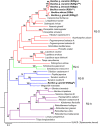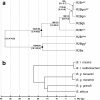Hybridogenesis and a potential case of R2 non-LTR retrotransposon horizontal transmission in Bacillus stick insects (Insecta Phasmida)
- PMID: 28165062
- PMCID: PMC5292737
- DOI: 10.1038/srep41946
Hybridogenesis and a potential case of R2 non-LTR retrotransposon horizontal transmission in Bacillus stick insects (Insecta Phasmida)
Abstract
Horizontal transfer (HT) is an event in which the genetic material is transferred from one species to another, even if distantly related, and it has been demonstrated as a possible essential part of the lifecycle of transposable elements (TEs). However, previous studies on the non-LTR R2 retrotransposon, a metazoan-wide distributed element, indicated its vertical transmission since the Radiata-Bilateria split. Here we present the first possible instances of R2 HT in stick insects of the genus Bacillus (Phasmida). Six R2 elements were characterized in the strictly bisexual subspecies B. grandii grandii, B. grandii benazzii and B. grandii maretimi and in the obligatory parthenogenetic taxon B. atticus. These elements were compared with those previously retrieved in the facultative parthenogenetic species B. rossius. Phylogenetic inconsistencies between element and host taxa, and age versus divergence analyses agree and support at least two HT events. These HT events can be explained by taking into consideration the complex Bacillus reproductive biology, which includes also hybridogenesis, gynogenesis and androgenesis. Through these non-canonical reproductive modes, R2 elements may have been transferred between Bacillus genomes. Our data suggest, therefore, a possible role of hybridization for TEs survival and the consequent reshaping of involved genomes.
Conflict of interest statement
The authors declare no competing financial interests.
Figures





Similar articles
-
Obligatory parthenogenesis and TE load: Bacillus stick insects and the R2 non-LTR retrotransposon.Insect Sci. 2017 Jun;24(3):409-417. doi: 10.1111/1744-7917.12322. Epub 2016 May 5. Insect Sci. 2017. PMID: 26813995
-
HYBRIDOGENESIS AND ANDROGENESIS IN THE STICK-INSECT BACILLUS ROSSIUS-GRANDII BENAZZII (INSECTA, PHASMATODEA).Evolution. 1992 Jun;46(3):783-796. doi: 10.1111/j.1558-5646.1992.tb02084.x. Evolution. 1992. PMID: 28568678
-
Evolutionary dynamics of R2 retroelement and insertion inheritance in the genome of bisexual and parthenogenetic Bacillus rossius populations (Insecta Phasmida).Insect Mol Biol. 2014 Dec;23(6):808-20. doi: 10.1111/imb.12126. Epub 2014 Aug 19. Insect Mol Biol. 2014. PMID: 25134735
-
Jumping the fine LINE between species: horizontal transfer of transposable elements in animals catalyses genome evolution.Bioessays. 2013 Dec;35(12):1071-82. doi: 10.1002/bies.201300072. Epub 2013 Sep 3. Bioessays. 2013. PMID: 24003001 Review.
-
Evolution of R1 and R2 in the rDNA units of the genus Drosophila.Genetica. 1997;100(1-3):49-61. Genetica. 1997. PMID: 9440258 Review.
Cited by
-
Divergent Gene Expression Following Duplication of Meiotic Genes in the Stick Insect Clitarchus hookeri.Genome Biol Evol. 2021 May 7;13(5):evab060. doi: 10.1093/gbe/evab060. Genome Biol Evol. 2021. PMID: 33885769 Free PMC article.
-
Holobionts and their hologenomes: Evolution with mixed modes of inheritance.Genet Mol Biol. 2018;41(1 suppl 1):189-197. doi: 10.1590/1678-4685-GMB-2017-0070. Epub 2018 Mar 1. Genet Mol Biol. 2018. PMID: 29505062 Free PMC article.
-
Lineage-Specific Evolution, Structural Diversity, and Activity of R2 Retrotransposons in Animals.bioRxiv [Preprint]. 2025 May 9:2025.05.05.652312. doi: 10.1101/2025.05.05.652312. bioRxiv. 2025. PMID: 40654615 Free PMC article. Preprint.
-
Successful Invasions of Short Internally Deleted Elements (SIDEs) and Its Partner CR1 in Lepidoptera Insects.Genome Biol Evol. 2019 Sep 1;11(9):2505-2516. doi: 10.1093/gbe/evz174. Genome Biol Evol. 2019. PMID: 31384954 Free PMC article.
References
-
- Chénais B., Caruso A., Hiard S. & Casse N. The impact of transposable elements on eukaryotic genomes: from genome size increase to genetic adaptation to stressful environments. Gene 509(1), 7–15 (2012). - PubMed
-
- Fujiwara H. Site specific non-LTR retrotransposons. Microbiol. Spectr. 3(2), MDNA3-0001-2014 (2015). - PubMed
-
- Loreto E. L. S., Carareto C. M. & Capy P. Revisiting horizontal transfer of transposable elements in Drosophila. Heredity 100, 545–554 (2008). - PubMed
-
- Silva J. C., Loreto E. L. & Clark J. B. Factors that affect the horizontal transfer of transposable elements. Curr. Issues Mol. Biol. 6, 57–71 (2004). - PubMed
Publication types
MeSH terms
Substances
LinkOut - more resources
Full Text Sources
Other Literature Sources

